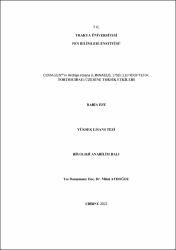Coragen'in Archips rosana (LİNNAEUS, 1758) (LEPIDOPTERA:TORTRICIDAE) üzerine etkileri
Özet
Tortricidae (Lepidoptera) familyası, çok sayıda zararlı tür içermesi nedeni ile bitki
korumada dikkat çekmektedir. Avrupa yaprak bükeni Archips rosana (Linnaeus, 1758),
Tortricidae familyasına ait zararlı bir gece kelebeği türüdür. Polifag olan bu tür özellikle
meyve bahçelerinde ekonomik zararlara neden olmaktadır. A. rosana, çeşitli bitki
yetiştiriciliğinde büyük ekonomik kayıplara yol açmakta ve bitki koruma açısından sorun
teşkil etmektedir.
Bu çalışma, Archips rosana’nın larva, pupa ve erginleri üzerinde etken maddesi
Chlorantraniliprole (CAP) (ticari adı Coragen®) olan insektisitin letal ve subletal
etkilerini belirlemeyi amaçlamaktadır. A. rosana’nın son dönem larvaları, Edirne ilinde
(Trakya Üniversitesi Balkan Arboreatumu) insektisitlere maruz kalmamış Ulmus minor
Miller (Ulmaceae) üzerinden doğrudan minimum temas ile toplanmış ve laboratuvara
getirilmiştir. A. rosana' nın 5. dönem larva, pupa ve ergin evreleri, letal konsantrasyon
LC50
'yi belirlemek için Coragen®’in tarımda tavsiye edilen uygulama konsantrasyonu
ve seyreltilmiş (1.10
-1
, 1.10
-2
, 1.10
-3
ve 1.10
-4
) konsantrasyonlarına maruz bırakılmıştır.
CAP’ün LC50
konsantrasyonları; larvalar için (48, 72 ve 96 saat), pupa (9 ve 12 gün) ve
ergin evreleri için (72 ve 96 saat) sırasıyla 25.751 µg/ml (48 saat), 1.715 µg/ml (72
saat), 0.499 µg/ml (96 saat), 14.216 µg/ml (9 gün), 8.62 µg/ml (12 gün) ve 41.178
µg/ml (72 saat), 1.895 µg/ml (96 saat) olarak bulunmuştur.
Azalan insektisit uygulamaları, çevreye ve insan sağlığına zararlı kimyasallara
maruz kalmanın azalması anlamına gelmektedir. Dolayısı ile bu çalışma sonucunda
Entegre Zararlı Yönetimi’nde kullanılmak üzere yeni veriler sağlayabilir. Bu konunun
seçilmesinin en önemli nedeni zararlılara karşı aşırı ve bilinçsiz insektisit kullanımını en
aza indirmeye yardımcı olmaktır. Bu anlamda Coragen® insektisitinin seyreltilmiş
uygulama konsantrasyonları, çevre kirliliği ve insan sağlığı açısından önemlidir. Tortricidae (Lepidoptera) family attracts attention in terms of plant protection, due
to its large number of harmful species. The European leafroller (ELR) Archips rosana
(Linnaeus, 1758) is a nocturnal moth species belonging to the Tortricidae family. This
polyphagous species causes economic damage especially in orchards. A. rosana is of
paramount importance in plant protection as it leads to great economic losses in various
plant cultivations.
This study aims to determine lethal and sublethal effects of the insecticide
Chlorantraniliprole (CAP) (trading name Coragen®) on larvae, pupae and adult of the
moth species A. rosana. Late stage larvae of A. rosana were collected from Ulmus
minor Miller (Ulmaceae) that were not exposed to insecticides in Edirne province
(Trakya University Balkan Arboreatum) with minimal contact and they were transferred
to the laboratory. The last 5
th
larva, pupae and adult stage of A. rosana were exposed to
agricultural recommended concentration (RC) and diluted concentration of RC (1.10
-1
,
1.10
-2
, 1.10
-3
and 1.10
-4
) of Coragen® to determine the lethal concentration LC50.
We
found that the LC50
concentrations of CAP for larvae (48, 72 and 96 h), pupae (9 and 12
days) and adult forms (72 and 96 h) were 25.751 µg/ml (48h), 1.715 µg/ml (72 h),
0.499 µg/ml (96 h), 14.216 µg/ml (9 days), 8.62 µg/ml (12 days) and 41.178 µg/ml (72
h), 1.895 µg/ml (96 h) respectively.
Decreased insecticide applications means decreased exposure to chemicals
hazardous to environment and human health. This study, therefore, can provide
contributive data to be used in Integrated Pest Management. The most important reason
for selecting this topic is help to minimize the excessive and unconscious use of
insecticides against pests. In this sense, diluted application concentrations of the
insecticide Coragen® are important in terms of environmental pollution and human
health.
Koleksiyonlar
- Tez Koleksiyonu [1287]


















